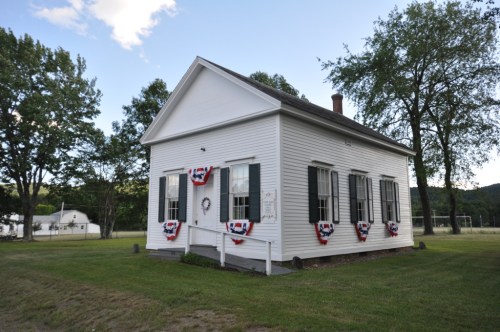Stones and Bones, where can they be? — The mystery of Vernon’s Vanished Cemetery, Part III
By Barbara Emery Moseley
Click here for the full series on the vanished Polly Lee Cemetery and the Peeler and Lee families
John and Polly (Peeler) Lee’s son George Washington Lee was, like his father, an accomplished builder/carpenter. At least one example of his skill remains in town. It is the Pond Road Chapel, built on land he owned. Funds were raised by subscription, and it cost about one thousand dollars. Completed in 1860 for the then recently organized congregation of Advent Christians, its architectural style is a modified Greek Revival, popular at the time.
Pond Road was then called the South Road, or City Road, and was a narrow dirt road, as they all were, throughout the town. In that year, Vernon’s population was 725, it had seven schools, 43 dogs, two churches and one Agricultural Library, which was purchased by 21 members at a cost of $105.
The Chapel succeeded Vernon’s first meeting house, a large two-story structure located on a bluff overlooking the river (above the location of the current Town Tomb). Built for the use of the Congregationalists and Baptists, it was used for Town Meetings as well.
When the railroad came through in 1844, the Meeting House was sold at auction, and soon a second church was built for $3,300, on the site of the present Union Church. It was a typical New England church of the 1800s, with a tall spire surmounted by a weathervane, and box pews within. Unfortunately, it was struck by lightning on June 15, 1899.
A young man, brawny blacksmith Paul Streeter, begged for help to scale the steeple and saw off the part that was slowly burning. No one was willing to help and the church was consumed as its heartsick parishioners watched. It was soon replaced by the present Union Church. Town Meetings were moved to the nearby Whithed House, with its large upstairs dance floor and stage.
George Washington Lee’s chapel thrived. Since services lasted all day, he built horse sheds on the north and west sides, and a board fence on the south side. He made it clear that the horse manure belonged to him.
The building was heated by a wood stove, from which a long stovepipe went across the ceiling, entering a chimney on the west side. The chimney was reached by a small trap door in the ceiling and was built only from the ceiling up and out above the range, a very strange arrangement.
Kerosene lamps hung in brackets at each window. Wooden deacon’s benches could seat about 100. Jacob Estey, president of Brattleboro’s Estey organ factory, gave his latest model reed organ. (The furnishings are intact today, but the building now has electricity and its oil lamps are just for “show.”)
Notable among its speakers was the famed American evangelist Dwight L. Moody. Born in Northfield in 1837, he became a shoe salesman in Boston and Chicago, until 1860, when he gave up business to devote himself to missionary work in Chicago, and started a sabbath school. In 1870 he met Ira D. Sankey, evangelist, hymn writer and compiler of popular hymns. They traveled together in England. When Moody spoke at the Pond Road Chapel, the benches were filled, the windows were opened, and people sat in their wagons and buggies outside to hear Moody’s booming voice.
Local people also attended his meetings at Belding’s Grove in South Vernon, and flocked to Northfield to hear him and Sankey. On one such trip, Jane Scott wrote in her diary on Sunday, September 2, 1877: “It was a disaster. The horse stumbled and fell and broke the shaft. Hurt my arm and side. Glad it is no worse. Rode home with Frank, and Lonzo came for the boys.”
Luckily, the incident did not require the use of the Town hearse, an elaborate horsedrawn vehicle with glassed-in sides revealing the coffin within. It was stored in the “hearse house” when not in use, on town-owned land near the mill pond.
The Town selectmen annually hired a driver to take charge of the hearse and to go with it “when used.” Among the drivers was Allender Peeler, who was “to have the sum of $1.50 each time, either by the friends of the deceased or by the Town.” No doubt trips were made to what became known as the Polly Lee Cemetery.
Photo By Magicpiano – Own work, CC BY-SA 3.0, https://commons.wikimedia.org/w/index.php?curid=49797570

